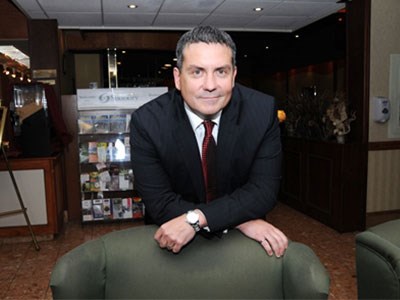Low commodity prices paired with the escalating costs of doing business means Vale will have to continue to evolve in order to maintain its competitive edge in the industry, according to Kelly Strong, Vale’s vice-president of Ontario and UK operations.
Speaking to a lunchtime crowd during a packed Sudbury Chamber of Commerce event April 16, Strong, who was promoted to his current role in November, noted that the $7-per-pound nickel prices of today are comparable in “dollars of the day” to the $2 and $3 prices of 10 years ago. But the costs of producing a pound of nickel have risen substantially, and only relate to operating and marketing costs—not capital investments.
“After 100 years of mining, the ore that was easy to get is now gone; we find ourselves going deeper and deeper,” said Strong, who was born in the North and spent most of his career as a miner. “We’re mining lower grades than we have in the past, making current cost structures not profitable, and in some cases not sustainable. We need to invest a significant amount of money in our mines to make sure that we’re mining here tomorrow.”
The company is also contending with a global market in which demand for nickel substitutes such as nickel pig iron—a low-grade ferrnonickel used to produce stainless steel—is increasing. It’s “here to stay and it’s a threat to our competitiveness,” Strong said.
To trim costs, Vale has had to reconfigure its organizational structure, including the reduction of some local jobs, Strong said. Yet jobs associated with purchasing and procurement, which had formerly been sourced out to Toronto or Brazil, are expected to return to Sudbury.
Strong acknowledged the mutually beneficial relationship between the company and the city’s mining supply and service sector, noting that Vale spent close to $1 billion with local vendors in 2012.
“The fact that we have one of the best supply and service sectors in the world puts us at a significant advantage taking into account this kind of spending, and the fact that we have the specialized skills and supplies available locally to keep our operations viable, and when you look at our local spend story, it’s nothing short of extraordinary,” he said.
A quest for sustainability has driven projects like the Challenging Ore Recovery (CORe) project at Clarabelle Mill, which will increase metal recovery by four per cent, and Totten Mine, Vale’s first new mine in 40 years, Strong said. With a 20-year mine life, it’s expected to start producing nickel, copper and PGMs by early next year.
The $1-billion Clean AER project will reduce emissions from the Copper Cliff smelter from current levels by 85 per cent. Originally projected to reduce emissions by 70 per cent, the forecasts were changed after Vale announced the Sudbury smelter would move from a two-furnace operation to a one-furnace operation by 2016.
That change involves “minimal adjustments to Sudbury mine production,” Strong said, noting that total refined nickel production at its operations wouldn’t change.
Vale is aiming make all these changes without sacrificing safety, Strong emphasized. Acknowledging the deaths in recent years of miners Jason Chenier, Jordan Fram and Stephen Perry, Strong said safety is his highest priority.
Last year, following Perry’s death at Coleman Mine, the company took a ‘safety pause,’ temporarily suspending production to focus on safety. During that time, employees, managers and supervisors worked to reduce the risk as much as possible.
“I’m pleased to tell you that with tremendous effort last year, 2012 was the lowest injury frequency rating we’ve had in the history of the company, and it’s something that we’re all very proud of,” Strong said.
Moving forward, Strong said the company would be mailing out its inaugural Report to the Community, an annual publication, to households and businesses in an effort to keep people informed about the changes at the company.
Fostering a good relationship with employees to keep them informed is also a priority for Strong, who said a collective effort is required to get through challenging times.




